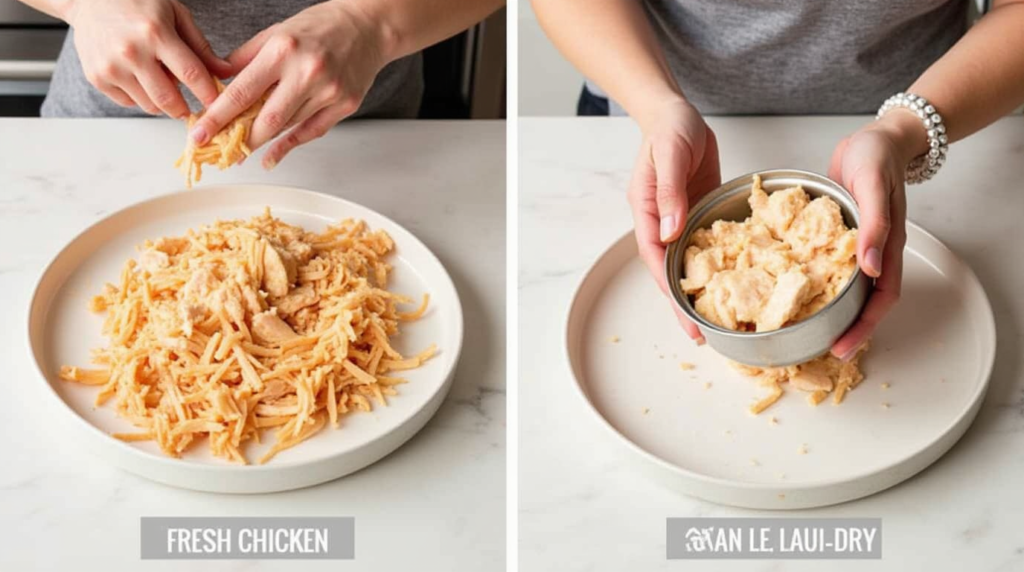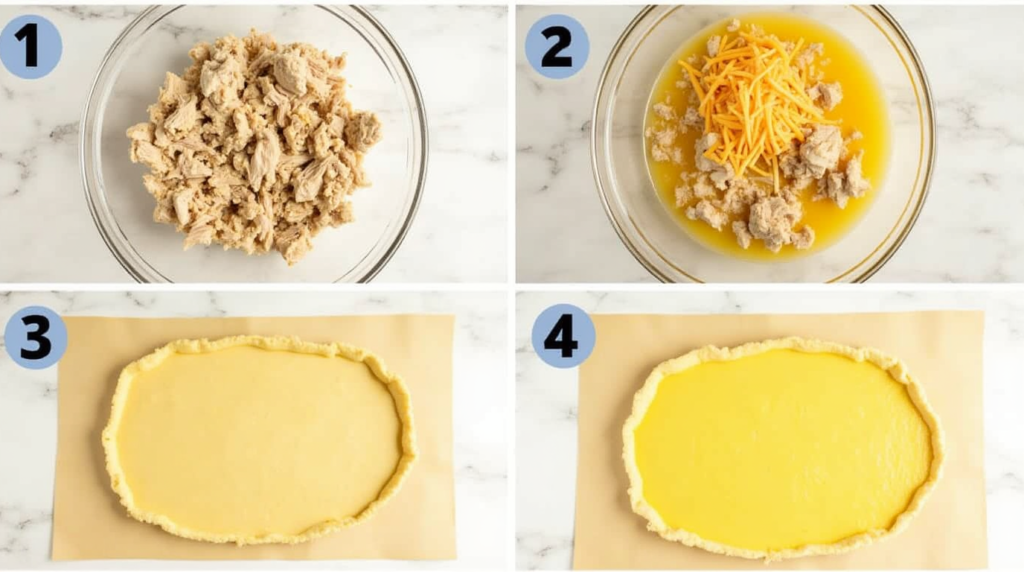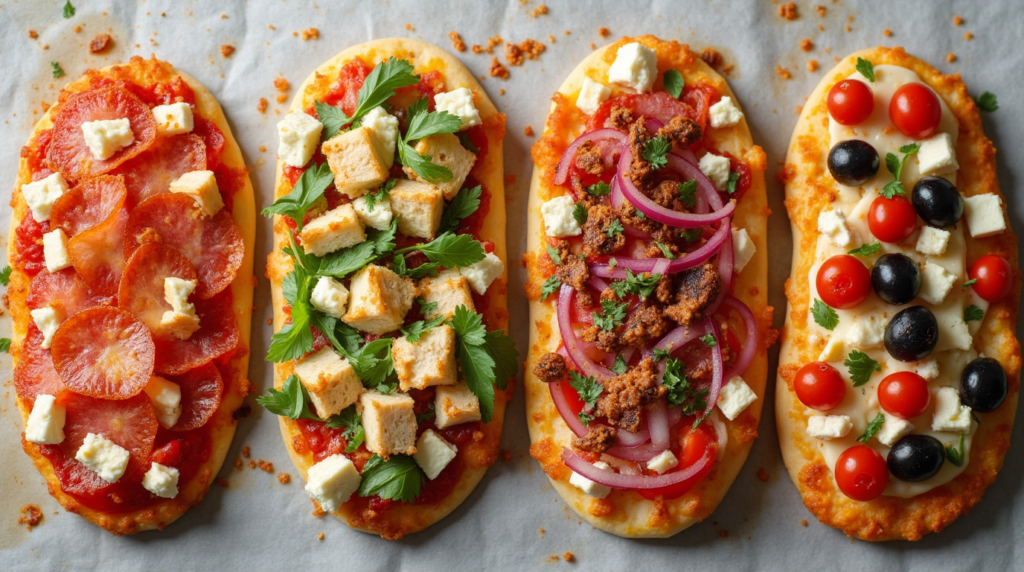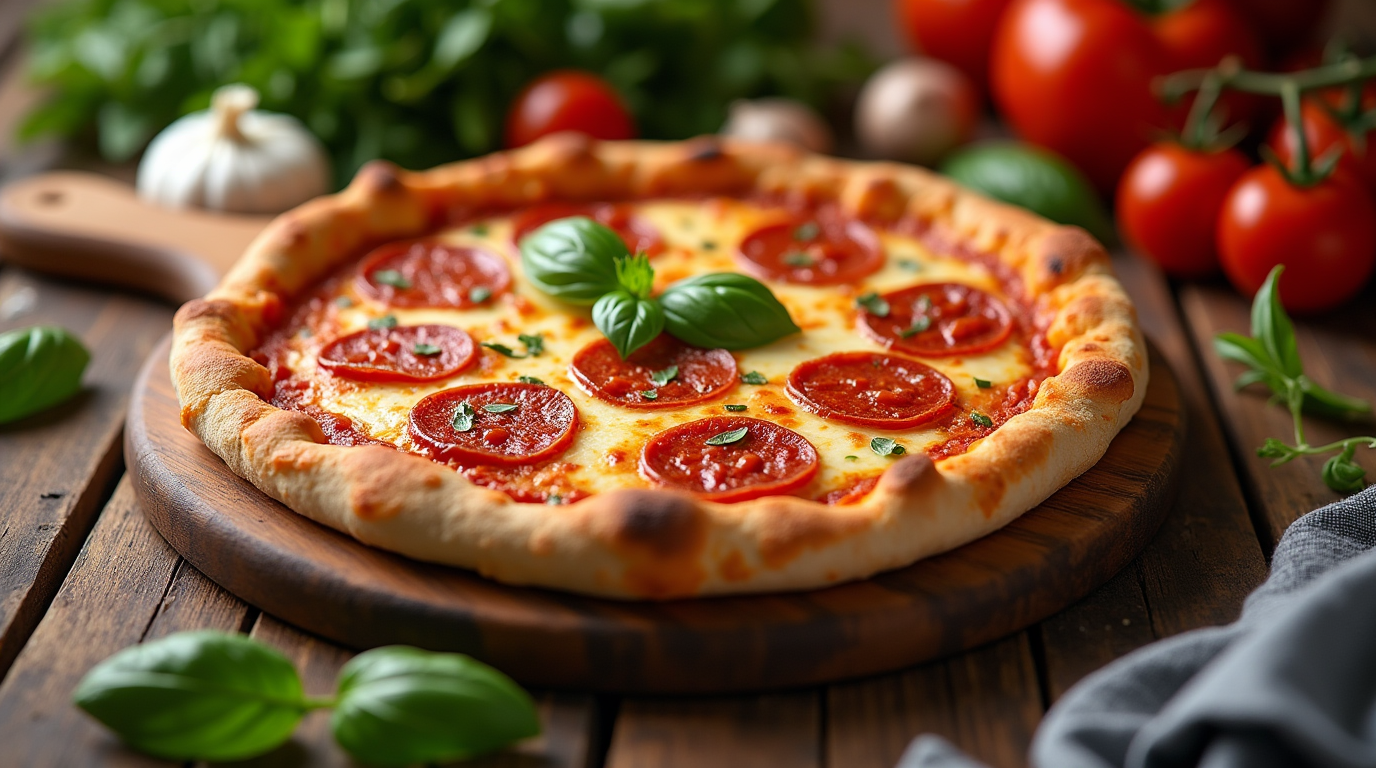Chicken Crust Pizza Recipe – Low-Carb, High-Protein Pizza Perfection
Table of Contents
Are you looking for a healthier Chicken Crust Pizza Recipe option that doesn’t compromise on taste? You’re in luck because a low-carb and high-protein pizza alternative is gaining popularity, and for good reason. This innovative dish is perfect for those who want to indulge in their pizza cravings without the guilt.
The genius of a protein-packed pizza base lies in its ability to satisfy your pizza cravings while providing a nutritious twist. Made with a unique blend of ingredients, this pizza is not only delicious but also aligns with various dietary preferences, making it a great option for a wide range of consumers.
Key Takeaways
- Discover a healthier pizza alternative that’s low in carbs and high in protein.
- Learn how to make a protein-packed pizza base that’s both nutritious and delicious.
- Understand the benefits of choosing a low-carb pizza option for your dietary needs.
- Explore the versatility of this innovative pizza recipe.
- Find out how this dish can be a game-changer for pizza lovers with dietary restrictions.
The Rise of Chicken Crust Pizza in Low-Carb Diets
The low-carb pizza revolution has a new hero: chicken crust pizza. As more people turn to low-carb diets for weight management and overall health, traditional pizza has often been off the menu due to its high-carb crust. However, chicken crust pizza offers a game-changing alternative that combines the pleasure of eating pizza with the benefits of a low-carb, high-protein diet.
Why Chicken Crust Pizza Is Gaining Popularity
Chicken crust pizza is gaining popularity for several reasons. Firstly, it caters to the growing demand for high-protein, low-carb foods. By using chicken as the crust, pizza lovers can enjoy their favorite dish without the carb overload from traditional dough. Additionally, chicken crust pizza is highly versatile, allowing for a wide range of toppings that can be tailored to fit various dietary needs and preferences.
Health Benefits of Choosing Chicken Over Traditional Dough
Choosing chicken crust over traditional dough comes with several health benefits. Chicken is an excellent source of protein, which is essential for muscle repair and growth. By opting for chicken crust, you’re not only reducing the carb content of your pizza but also increasing its protein content. This makes chicken crust pizza an attractive option for those looking to manage their weight or support muscle health.
| Nutritional Aspect | Traditional Pizza Crust | Chicken Crust Pizza |
|---|---|---|
| Protein Content | Low-Moderate | High |
| Carb Content | High | Low |
| Fat Content | Moderate-High | Variable (depends on chicken and toppings) |
As shown in the table, chicken crust pizza offers a nutritional profile that is more aligned with low-carb dietary requirements, making it a healthier alternative to traditional pizza.
Understanding the Basics of Chicken Crust Pizza
The concept of using chicken as a crust for pizza is gaining traction, and for good reason, as it combines the best of both worlds – protein and taste. As you explore the world of low-carb pizzas, understanding the fundamentals of chicken crust pizza is essential.
What Makes Chicken Crust Different from Other Low-Carb Options
Chicken crust pizza stands out from other low-carb alternatives due to its high protein content and the absence of grains or high-carb ingredients. Unlike cauliflower crust or fathead dough, chicken crust is made primarily from ground chicken, making it an attractive option for those looking to increase their protein intake. Here are some key differences:
- Protein Content: Chicken crust pizza is significantly higher in protein compared to other low-carb crusts.
- Ingredient List: The ingredients are straightforward, typically involving ground chicken, eggs, cheese, and seasonings.
- Taste and Texture: It offers a more traditional pizza texture compared to vegetable-based crusts.
Nutritional Profile: Protein, Fat, and Carb Content
Understanding the nutritional profile of chicken crust pizza is crucial for making informed dietary choices. A typical serving of chicken crust pizza contains:
| Nutrient | Amount per Serving |
|---|---|
| Protein | Approximately 20-25 grams |
| Fat | About 10-12 grams, depending on the toppings and cheese used |
| Carbohydrates | Less than 5 grams, making it suitable for low-carb diets |
By choosing chicken crust pizza, you’re opting for a meal that’s not only delicious but also aligns with various dietary preferences, including low-carb and high-protein diets.
Essential Ingredients for the Perfect Chicken Pizza Crust
Making a delicious chicken crust pizza begins with selecting the right ingredients for the crust. The quality and type of ingredients you choose will significantly impact the final product’s taste, texture, and nutritional value.
Fresh vs. Canned Chicken Options
When it comes to choosing between fresh and canned chicken for your pizza crust, there are several factors to consider. Fresh chicken offers better texture and flavor, allowing you to control the cooking and shredding process. On the other hand, canned chicken is convenient and can save time. However, it may contain added sodium and preservatives. If you opt for canned chicken, ensure you drain it properly to remove excess moisture.

Binding Agents: Eggs, Cheese, and Alternatives
Binding agents are crucial in holding your chicken crust together. Eggs are a popular choice due to their protein content and ability to bind ingredients. Cheese, particularly mozzarella or parmesan, not only acts as a binder but also adds flavor. For those looking for alternatives, almond flour or coconut flour can be used, though they may alter the crust’s texture slightly. Experimenting with different binding agents can help you achieve the perfect balance for your chicken crust pizza.
Seasonings That Enhance Flavor
Seasonings play a vital role in enhancing the flavor of your chicken crust pizza. Italian seasoning, garlic powder, and onion powder are popular choices that complement the chicken well. You can also add dried herbs like oregano or basil to give your crust an authentic pizza flavor. Don’t be afraid to experiment with different seasoning combinations to find what works best for you.
Optional Ingredients for Texture and Taste
To further enhance your chicken crust pizza, consider adding optional ingredients that can improve texture and taste. Chopped vegetables like bell peppers or onions can add crunch, while a sprinkle of nutritional yeast can provide a cheesy, nutty flavor. For an extra crispy crust, you might try adding a small amount of coconut flour or almond flour. These ingredients can be adjusted based on your dietary preferences and the texture you’re aiming for.
Step-by-Step Chicken Crust Pizza Recipe
To create a delicious chicken crust pizza, you’ll need to follow a few simple steps that ensure a crispy crust and flavorful toppings. This guide will walk you through the process, from preparing the chicken to adding your favorite toppings.

Preparing and Shredding the Chicken
The first step in making a chicken crust pizza is to prepare the chicken. You can use cooked chicken breast or thighs, whichever you prefer. Shred the chicken into fine pieces using a food processor or a couple of forks. It’s essential to remove any excess moisture from the shredded chicken to ensure the crust holds together properly. You can do this by squeezing out the moisture with a paper towel or a clean kitchen cloth.
Mixing and Forming the Perfect Crust
Once your chicken is prepared, it’s time to mix it with other ingredients to form the crust. In a bowl, combine the shredded chicken with eggs, cheese, and your choice of seasonings. Mix everything together until you have a consistent mixture. Then, shape the mixture into a circle or rectangle, depending on your preference, on a baking sheet lined with parchment paper. Make sure the crust is evenly spread and not too thick, as this can affect the crispiness.
Pre-Baking Techniques for Crispy Results
Pre-baking the crust is a crucial step to achieve a crispy base. Preheat your oven to 400°F (200°C). Place the baking sheet with the shaped crust in the oven and bake for about 15-20 minutes, or until the crust is golden brown and firm to the touch. Keep an eye on it to prevent overcooking. Removing the crust from the oven and letting it cool slightly will help in achieving the perfect texture.
Adding Toppings and Final Baking
After pre-baking the crust, you can add your favorite toppings. Spread a layer of pizza sauce over the crust, followed by cheese and your choice of toppings. Be mindful of the topping quantity to avoid overwhelming the crust. Return the pizza to the oven and bake for an additional 10-15 minutes, or until the cheese is melted and bubbly. Remove it from the oven, let it cool for a few minutes, and then slice and serve.
By following these steps, you can enjoy a delicious homemade chicken crust pizza that’s not only tasty but also aligns with your low-carb dietary preferences.
Delicious Topping Combinations for Your Chicken Crust Pizza
Now that you’ve mastered the art of making chicken crust pizza, it’s time to explore the world of delicious topping combinations. The beauty of this low-carb, high-protein pizza lies in its versatility, allowing you to get creative with a variety of toppings that cater to your taste preferences.

Classic Pizza Toppings That Work Well
Classic pizza toppings such as mozzarella cheese, pepperoni, and fresh basil are timeless favorites that work exceptionally well on chicken crust pizza. You can also consider adding other traditional toppings like mushrooms, olives, or bell peppers to create a pizza that suits your taste.
- Mozzarella cheese for a creamy texture
- Pepperoni for a spicy kick
- Fresh basil for a burst of freshness
Chicken Caesar Pizza Variation
For a unique twist, try making a Chicken Caesar pizza by topping your chicken crust with Caesar dressing, grilled chicken, and parmesan cheese. This combination offers a rich, savory flavor profile that’s sure to satisfy.
Key ingredients:
- Caesar dressing as the sauce
- Grilled chicken for added protein
- Parmesan cheese for a salty, nutty flavor
BBQ Chicken Pizza Adaptation
BBQ chicken pizza is another delicious variation you can try. Simply top your chicken crust with BBQ sauce, shredded chicken, red onions, and cilantro for a sweet and tangy pizza that’s perfect for those who love BBQ flavors.
Mediterranean-Inspired Toppings
If you prefer a Mediterranean twist, consider topping your chicken crust pizza with feta cheese, Kalamata olives, artichoke hearts, and sun-dried tomatoes. This combination brings a flavorful and healthy spin to your pizza.
Recommended toppings:
- Feta cheese for a tangy taste
- Kalamata olives for a salty flavor
- Artichoke hearts for a unique texture
Low-Carb Topping Considerations
When choosing toppings, remember to keep your selections low in carbs to maintain the dietary benefits of your chicken crust pizza. Opt for vegetables, lean proteins, and healthy fats to create a balanced and nutritious meal.
Troubleshooting Your Chicken Dough Pizza
A few common issues can arise when making a chicken crust pizza, but they’re easy to fix. Whether you’re a seasoned chef or a beginner in the kitchen, troubleshooting is a crucial step in achieving pizza perfection.
When making a chicken crust pizza, you might encounter some challenges, such as a crust that’s too wet or too dry, or one that sticks to the baking surface. Understanding how to address these issues will help you create a delicious, high-quality pizza.
Fixing a Crust That’s Too Wet or Too Dry
A crust that’s too wet or too dry can be a major issue. If your crust is too wet, it might be due to excess moisture from the chicken or other ingredients. To fix this, try draining excess moisture or adding more binding agents like eggs or cheese. On the other hand, if your crust is too dry, it could be due to overcooking or insufficient moisture. Adjusting your cooking time or adding a bit more moisture can help.
Preventing the Crust from Sticking
Preventing the crust from sticking to the baking surface is crucial. To achieve this, make sure to grease your baking sheet properly or use parchment paper. You can also try dusting the surface with a small amount of cheese or almond flour to prevent sticking.
Achieving the Perfect Texture and Crispiness
Achieving the perfect texture and crispiness is key to a great chicken crust pizza. To get a crispy crust, pre-bake the crust before adding toppings. This helps to remove excess moisture and crisp up the crust. Additionally, using the right cooking temperature and time can make a big difference. Experiment with different temperatures and cooking times to find what works best for you.
By troubleshooting common issues and adjusting your techniques, you can create a delicious chicken crust pizza with a perfect crust texture.
Canned Chicken Pizza Crust Recipe Variation
Using canned chicken for your pizza crust is a clever hack that saves time and effort. This variation of the chicken crust pizza recipe is perfect for those who want to enjoy a low-carb, high-protein meal without spending too much time in the kitchen.
Canned chicken can be a convenient alternative to fresh chicken, and with the right preparation, it can result in a delicious and crispy crust. Here’s how you can make it work.
Step-by-Step Instructions for Canned Chicken Crust
To make a canned chicken pizza crust, start by draining the liquid from the can and rinsing the chicken. Then, mix the chicken with some eggs, cheese, and your choice of seasonings. Shape the mixture into a circle or rectangle, depending on your preference, and bake until crispy.
- Drain and rinse the canned chicken
- Mix with eggs, cheese, and seasonings
- Shape into a crust
- Bake until crispy
Draining and Preparing Canned Chicken Properly
Proper preparation of canned chicken is crucial for a good crust. Make sure to drain the liquid and rinse the chicken under cold water to remove excess sodium. You can also pat the chicken dry with a paper towel to remove excess moisture.
Tip: Rinsing canned chicken can significantly reduce its sodium content, making it a healthier option.
Benefits and Limitations of Using Canned Chicken
Using canned chicken has its benefits, such as convenience and a longer shelf life. However, it may also contain added preservatives and sodium. Be sure to choose a brand with minimal additives and follow proper preparation techniques.
“Canned goods like chicken can be a nutritious and convenient addition to a meal when chosen wisely.” –
Nutrition Expert
In conclusion, canned chicken can be a viable alternative for making chicken crust pizza. By following the right preparation steps and being mindful of the potential limitations, you can enjoy a tasty and convenient meal.
Comparing Chicken Crust to Other Low-Carb Pizza Alternatives
The quest for a low-carb pizza has led to the development of several crust alternatives. As you’ve considered chicken crust pizza, it’s worth comparing it to other popular low-carb options like cauliflower crust, fathead dough, and almond flour crust. Each of these alternatives has its unique characteristics, advantages, and disadvantages. Understanding these differences can help you make an informed decision about which low-carb crust is best for your dietary needs.
Cauliflower Crust: Pros and Cons
Cauliflower crust has gained popularity due to its low-carb content and vegetable-based ingredients. The pros include its low calorie and carb count, making it suitable for very low-carb diets. However, it can be prone to sogginess and may lack the structural integrity of other crusts.
Fathead Dough: Nutritional Comparison
Fathead dough, made with mozzarella, cream cheese, and almond flour, offers a different nutritional profile compared to chicken crust. It is higher in fat but can be a good option for those on a keto diet. Here’s a comparison table:
| Nutritional Aspect | Chicken Crust | Fathead Dough |
|---|---|---|
| Calories | 250-300 per serving | 350-400 per serving |
| Protein Content | High (approx. 25g) | Low (approx. 10g) |
| Carb Content | Low (approx. 5g) | Low (approx. 5g) |
| Fat Content | Moderate (approx. 10g) | High (approx. 25g) |
Almond Flour Crust: Taste and Texture Differences
Almond flour crust offers a nutty flavor and a delicate texture that is different from both chicken crust and fathead dough. It is relatively low in carbs but high in calories due to its fat content. The texture can be more crumbly, requiring careful handling to prevent breakage.
Which Low-Carb Crust Is Right for Your Diet?
Choosing the right low-carb crust depends on your dietary goals and preferences. If you’re looking for high protein and moderate fat, chicken crust might be the best option. For a keto diet, fathead dough could be more suitable. Cauliflower crust is ideal for those watching their calorie intake, and almond flour crust works well for those who prefer a gluten-free, nutty flavor.
Conclusion
You now have the tools to create a delicious, high-protein pizza that fits perfectly into your low-carb diet. The chicken crust pizza recipe offers a game-changing alternative to traditional pizza, providing a crispy crust without the need for carb-heavy dough.
By choosing this recipe, you’re not only reducing your carb intake but also increasing your protein consumption, making it an ideal meal for those looking to maintain a healthy lifestyle. Experiment with different topping combinations to keep your meals exciting and tailored to your taste preferences.
Whether you’re following a specific diet or simply looking for a healthier pizza option, this chicken crust pizza is sure to become a favorite. So, go ahead and get creative with your toppings and enjoy a guilt-free pizza night that aligns with your dietary goals.
FAQ
What is chicken crust pizza?
Chicken crust pizza is a type of pizza that uses a crust made from chicken instead of traditional dough, making it a low-carb and high-protein alternative.
How do I make a chicken crust pizza?
To make a chicken crust pizza, you need to prepare and shred chicken, mix it with binding agents like eggs and cheese, form the crust, pre-bake it, and then add your desired toppings before baking it to perfection.
Can I use canned chicken for chicken crust pizza?
Yes, you can use canned chicken as a convenient alternative to fresh chicken for making chicken crust pizza. Just make sure to drain and prepare it properly.
What are the benefits of using chicken crust pizza over traditional pizza?
Chicken crust pizza offers several benefits, including being low in carbs, high in protein, and potentially lower in calories, making it a popular choice for those following a low-carb diet or looking for a healthier pizza option.
How do I prevent my chicken crust from sticking to the baking sheet?
To prevent your chicken crust from sticking, you can use parchment paper or lightly grease the baking sheet with a small amount of oil or cooking spray.
Can I customize my chicken crust pizza with different toppings?
Absolutely, you can customize your chicken crust pizza with a variety of toppings, from classic pizza toppings to more unique combinations like chicken Caesar or Mediterranean-inspired toppings.
How does chicken crust pizza compare to other low-carb pizza alternatives?
Chicken crust pizza is one of several low-carb pizza alternatives, with others including cauliflower crust, fathead dough, and almond flour crust. Each has its pros and cons, and the best choice depends on your dietary needs and preferences.
Is chicken crust pizza suitable for a keto diet?
Chicken crust pizza can be a good option for a keto diet, depending on the ingredients used for the crust and the toppings. It’s high in protein and can be low in carbs, but it’s essential to choose keto-friendly toppings.
Leave a Review & Rate This Recipe!
There are no reviews yet. Be the first one to write one.

